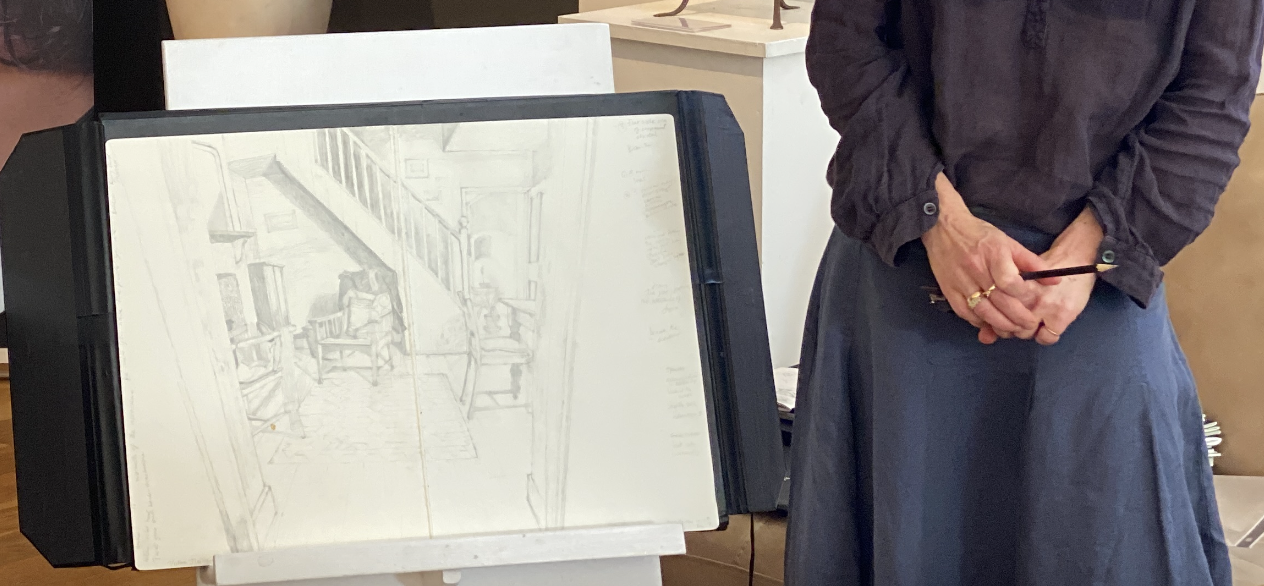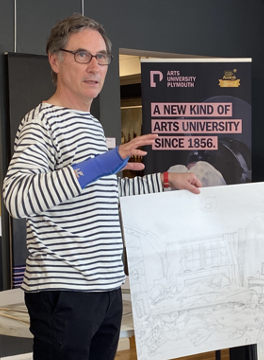Drawing Daily | A way of making sense of ourselves and the world around us
Learning by looking so that we can then imagine

Inspired by the theory of Learning as a Generative Activity, and Artist - Richard Kenton Webb - we are building a project that questions whether the discipline of drawing daily supports our ability to make sense of ourselves and the world around us. We will drop thoughts here on this page as well as how this idea evolves and impacts us all at Mayflower.
Richard kicked things off with his forum in Modbury. Questions were posed such as, how do you look and what is normal?
Scribbled notes from the forum...
Great art isn't said it's always saying
In other words it's always relevant and of the moment
Painting captures the intensity of living of being other than ourselves
To dare difference
Different futures
It's inclusive and has values
Metamorphic matter into thought
It's where - Our body and soul are me but not me
We need art to further ourselves - our creative imagination
Art is at a disadvantage - an unnecessary part of doing things - of society
COVID taught us the dangers of relying on technology - it isn't evil but could be
Painting doesn't need electricity - it's primitive and elemental that we need to be in touch with
Drawing is basic and simple as a way of looking at yourself - a basic way of looking (of noticing)
A powerful thing as a human is our creative imagination
If we don't know how to make sense do what we see it's difficult to pull what's inside to out
Book 'playing reality' a potential space between us and the world
We understand the world by making it visible
'The extended mind'
Learning by looking so that we can then imagine
Drawing is a lifelong commitment - the more you look the more you see
We learn to draw before we learn to speak - it's so primal and necessary
Connecting brain and hand - to connect imagination to our reality
Understand through drawing - positioning | where one thing is in relation to another
A question might never be answered, and often just sits there, but often it follows you around
An idea: an aspect perception - so much of the world is there but not seen.
We haven't seen its aspect.
As a teacher we teach visually and also neurologically diverse
- Line
- Shape or form
- Movement
- Space - Spacial|ness
- Tone
- Colour
Book - 'The place of a colourblind painter'
Repetition of shapes and forms like a kind of musical awareness
Shapes forming and repeating like musical composition
Using line and shapes of tone to find certain aspects in the room that might then make a painting
'To record the seeing process' | use our periphery vision e.g. the door bends
A photograph would look completely different - insist on drawing
Comprehend how things fit together through your eyes
You're leading the viewer into the room using shapes and forms (unlike a camera) to experience the room or space
An embodied experience
The viewer joins the painter in the experience as a composition
Living thinking thought is saying something - still - it's not said it's saying
Could we write on drawings | thoughts or observations as part of its history
Colour and shape
No line - but colour and shape can suggest line
Sensory - a disciplined act of making sense of things - representing both figurative as well as abstract or sign the land
Select - organise - integrate and make sense of and represent other things and ideas | this is what is going on through observational drawing
If you want to make work through imagination - observational drawings give a well of images to draw upon
A visual poet | a feeling | a vision | I've already seen it
Be seriously humorous | vulnerable
The visual poet imagining | what if...
That you're carrying something important
'The Blue Mantle'
Declare | a calling | no impostor syndrome | something to say | I am...!
The way I draw, and I look | (the way I live)
Why are you a painter | what's the role of the painter?
Intuitively work things out
The spectrum
Vulnerability and honesty
It's not about looks - it's about feeling
Visual vs Haptic

